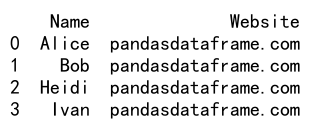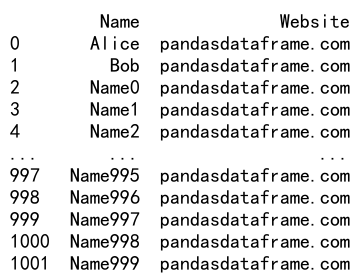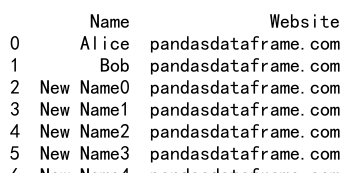Pandas Append Rows
Pandas is a powerful Python library used for data manipulation and analysis. One of the common operations when working with data is appending rows to an existing DataFrame. This can be useful in various scenarios, such as when you are aggregating data from multiple sources or when you need to update your dataset with new observations. In this article, we will explore different ways to append rows to a DataFrame using Pandas, providing detailed examples for each method.
Introduction to DataFrame
A DataFrame is a two-dimensional, size-mutable, potentially heterogeneous tabular data structure with labeled axes (rows and columns). Before diving into the specifics of appending rows, let’s first create a simple DataFrame to work with in our examples.
Example 1: Creating a Basic DataFrame
import pandas as pd
# Create a DataFrame
data = {'Name': ['Alice', 'Bob'], 'Website': ['pandasdataframe.com', 'pandasdataframe.com']}
df = pd.DataFrame(data)
print(df)
Output:

Appending Rows to a DataFrame
Appending rows to a DataFrame can be done in several ways, including using the append() method, the concat() function, and more recently, the pd.concat() or DataFrame.append() methods as recommended by Pandas documentation.
Example 2: Appending a Single Row Using append()
import pandas as pd
# Create a DataFrame
data = {'Name': ['Alice', 'Bob'], 'Website': ['pandasdataframe.com', 'pandasdataframe.com']}
df = pd.DataFrame(data)
new_row = {'Name': 'Charlie', 'Website': 'pandasdataframe.com'}
df = df._append(new_row, ignore_index=True)
print(df)
Output:

Example 3: Appending Multiple Rows Using append()
import pandas as pd
# Create a DataFrame
data = {'Name': ['Alice', 'Bob'], 'Website': ['pandasdataframe.com', 'pandasdataframe.com']}
df = pd.DataFrame(data)
new_rows = pd.DataFrame([
{'Name': 'David', 'Website': 'pandasdataframe.com'},
{'Name': 'Eve', 'Website': 'pandasdataframe.com'}
])
df = df._append(new_rows, ignore_index=True)
print(df)
Output:

Example 4: Appending Rows Using concat()
import pandas as pd
# Create a DataFrame
data = {'Name': ['Alice', 'Bob'], 'Website': ['pandasdataframe.com', 'pandasdataframe.com']}
df = pd.DataFrame(data)
new_rows = pd.DataFrame([
{'Name': 'Frank', 'Website': 'pandasdataframe.com'},
{'Name': 'Grace', 'Website': 'pandasdataframe.com'}
])
df = pd.concat([df, new_rows], ignore_index=True)
print(df)
Output:

Example 5: Using concat() with a List of DataFrames
import pandas as pd
# Create a DataFrame
data = {'Name': ['Alice', 'Bob'], 'Website': ['pandasdataframe.com', 'pandasdataframe.com']}
df = pd.DataFrame(data)
additional_rows = pd.DataFrame([
{'Name': 'Heidi', 'Website': 'pandasdataframe.com'},
{'Name': 'Ivan', 'Website': 'pandasdataframe.com'}
])
df = pd.concat([df, additional_rows], ignore_index=True)
print(df)
Output:

Advanced Appending Techniques
Beyond simple appending, Pandas allows for more complex operations that can be tailored to specific needs, such as appending rows conditionally or handling duplicate entries.
Example 6: Appending Rows Conditionally
import pandas as pd
# Create a DataFrame
data = {'Name': ['Alice', 'Bob'], 'Website': ['pandasdataframe.com', 'pandasdataframe.com']}
df = pd.DataFrame(data)
new_data = pd.DataFrame([
{'Name': 'John', 'Website': 'pandasdataframe.com'},
{'Name': 'Jane', 'Website': 'pandasdataframe.com'}
])
df = pd.concat([df, new_data[new_data['Name'].str.startswith('J')]], ignore_index=True)
print(df)
Output:

Example 7: Handling Duplicates When Appending
import pandas as pd
# Create a DataFrame
data = {'Name': ['Alice', 'Bob'], 'Website': ['pandasdataframe.com', 'pandasdataframe.com']}
df = pd.DataFrame(data)
new_data = pd.DataFrame([
{'Name': 'Alice', 'Website': 'pandasdataframe.com'},
{'Name': 'Bob', 'Website': 'pandasdataframe.com'}
])
df = pd.concat([df, new_data]).drop_duplicates()
print(df)
Output:

Example 8: Appending Rows with Different Columns
import pandas as pd
# Create a DataFrame
data = {'Name': ['Alice', 'Bob'], 'Website': ['pandasdataframe.com', 'pandasdataframe.com']}
df = pd.DataFrame(data)
new_row = pd.DataFrame([{'Name': 'Kyle', 'Email': '[email protected]'}])
df = pd.concat([df, new_row], ignore_index=True, sort=False)
print(df)
Output:

Performance Considerations
When working with large datasets, the efficiency of appending operations becomes crucial. Here are some tips and examples on how to append rows efficiently.
Example 9: Pre-allocating Space for Large Appends
import pandas as pd
# Create a DataFrame
data = {'Name': ['Alice', 'Bob'], 'Website': ['pandasdataframe.com', 'pandasdataframe.com']}
df = pd.DataFrame(data)
# Suppose we need to append 1000 new rows
new_data = pd.DataFrame({
'Name': ['Name' + str(i) for i in range(1000)],
'Website': ['pandasdataframe.com'] * 1000
})
df = pd.concat([df, new_data], ignore_index=True)
print(df)
Output:

Example 10: Using append() in a Loop (Not Recommended)
import pandas as pd
# Create a DataFrame
data = {'Name': ['Alice', 'Bob'], 'Website': ['pandasdataframe.com', 'pandasdataframe.com']}
df = pd.DataFrame(data)
for i in range(5):
df = df._append({'Name': 'New Name' + str(i), 'Website': 'pandasdataframe.com'}, ignore_index=True)
print(df)
Output:

Pandas Append Rows Conclusion
Appending rows to a DataFrame is a common task in data analysis and manipulation. Pandas provides several methods to accomplish this, each with its own use cases and performance implications. By understanding these methods and when to use them, you can efficiently manage and manipulate your data in Python.
This article has provided a comprehensive guide on how to append rows to a DataFrame using Pandas, complete with practical examples. Whether you are dealing with small datasets or large-scale data, these techniques will help you perform data append operations effectively.
 Pandas Dataframe
Pandas Dataframe